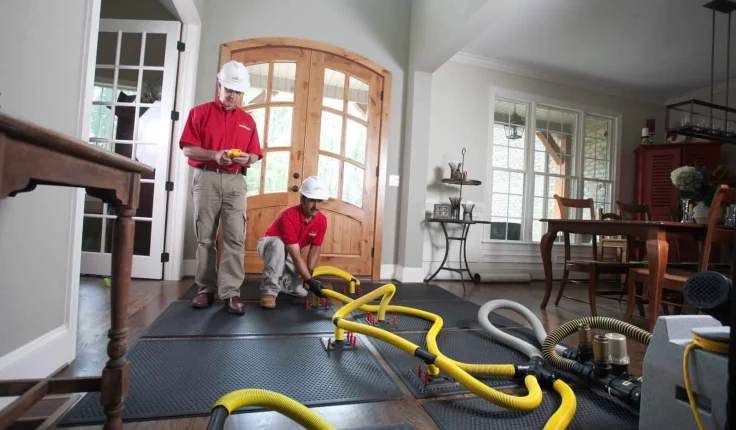What Steps Are Involved in Professional Flood Restoration Services?

When your home or business experiences a flood, the aftermath can feel overwhelming. Water spreads quickly, damaging flooring, walls, furniture, and personal belongings within minutes. Mold can begin developing in as little as 24 hours, and structural materials weaken the longer they remain saturated. This is why reaching out for professional flood restoration services is essential. Experts follow a detailed, methodical process designed to restore your property safely and efficiently. Below, we break down the key steps involved so you know exactly what to expect.
What Is the First Step in Professional Flood Restoration Services? – Emergency Response and Inspection
The restoration process always begins with a rapid response. Professional teams know that time is critical, especially during emergencies like basement flood clean up. Once you call, a certified specialist arrives to assess the situation. They evaluate the source of the water, the safety conditions, and the extent of the damage.
During the inspection phase, specialists:
- Identify the water category (clean, grey, or black water).
- Measure moisture levels using professional meters.
- Document affected areas with photos and notes.
- Develop a customized restoration plan.
This initial evaluation helps determine the equipment needed and the scope of work. Companies like Ideal Response emphasize accurate assessments to prevent hidden moisture issues that could cause mold growth or structural deterioration later.
Why Is Water Extraction Crucial in Flood Restoration Services? – Removing Standing Water
Once the inspection is complete, technicians begin removing all standing water. The longer water sits, the more damage it causes. Advanced pumps, vacuums, and truck-mounted extraction units remove water far more effectively than household tools.
Professionals focus on:
- Extracting large volumes of water quickly
- Removing water from carpets, subfloors, and foundations
- Preventing secondary water migration into unaffected rooms
In severe situations like deep basement flooding, high-capacity extraction pumps are essential. Fast water removal also reduces the risk of electrical hazards and mold contamination. At this stage, the environment becomes safer for the next phases of restoration.
How Do Experts Handle Damaged Materials During Basement Flood Clean Up? – Sorting and Disposal
Floodwater often affects materials differently. Some can be dried and restored; others must be disposed of for safety reasons, especially when contaminated water is involved.
Technicians categorize items into:
- Restorable materials, such as some furniture, plastics, and structural components
- Non-restorable materials, including saturated insulation, drywall, carpeting, and porous items exposed to dirty water
Proper disposal prevents bacteria from spreading and ensures your home returns to a safe environment. In the case of basement flood clean up, professionals may also remove debris, mud, or silt carried in by the flood.
What Role Does Drying and Dehumidification Play in Flood Restoration Services? – Removing Hidden Moisture
After the bulk water has been removed, the drying process begins. This step is vital because building materials absorb moisture deeply, even when surfaces look dry.
Experts use:
- Industrial-grade air movers
- Low-grain refrigerant dehumidifiers
- Specialized drying mats for hardwood floors
- Wall cavity drying systems
Technicians position equipment strategically to create optimal airflow throughout the affected area. They also monitor moisture levels daily, adjusting equipment as needed. The drying stage ensures hidden moisture is eliminated, preventing mold growth and preserving the structural integrity of your property.
How Do Specialists Clean and Sanitize After a Flood? – Deep Cleaning and Disinfection
Floodwater is often contaminated with bacteria, chemicals, and debris. Even clean water can become hazardous within hours. After drying, professional teams thoroughly clean and sanitize all affected surfaces.
This stage includes:
- Antimicrobial treatment to prevent mold
- Sanitizing floors, walls, and structural elements
- Cleaning salvageable personal items
- Odor removal using specialized deodorization tools
Companies like Ideal Response use industry-approved cleaning agents to ensure the environment becomes safe for occupants. Deep cleaning is especially important for families with children, older adults, or people with allergies.
What Steps Prevent Mold After Flooding? – Mold Prevention and Remediation
Mold can spread rapidly after a flood, especially when humidity remains high. Professionals take several steps to prevent or treat mold growth.
Their process may include:
- Applying mold-inhibiting treatments
- Removing mold-contaminated materials
- HEPA vacuuming affected surfaces
- Using air scrubbers to filter microscopic spores
In cases where mold is already present, technicians perform full remediation to restore air quality and prevent future outbreaks.
Why Is Structural Repair an Important Part of Flood Restoration Services? – Rebuilding and Repairing Damaged Areas
Restoration doesn’t end with drying and cleaning. Many properties need reconstruction to return to their pre-flood condition. Depending on the extent of the damage, this may include:
- Replacing drywall and insulation
- Installing new flooring or carpeting
- Repairing structural supports
- Painting or refinishing surfaces
- Restoring damaged plumbing or electrical systems
Some restoration companies have in-house rebuilding teams, while others coordinate with licensed contractors. Either way, the goal is to restore the property both functionally and visually.
How Do Professionals Ensure the Property Is Fully Restored? – Final Inspection and Documentation
The final step involves a thorough walkthrough. Technicians inspect:
- Moisture levels in all previously affected areas
- Air quality and humidity levels
- Structural repairs
- Cleanliness and sanitation
They also provide documentation for insurance claims, including photos, reports, and a list of completed tasks. This documentation makes the claims process smoother and helps you receive proper compensation for the damage.
Conclusion: Why Choose Professionals for Flood Restoration Services?
Handling flood damage alone is risky, time-consuming, and often ineffective. Professional flood restoration services follow a structured, proven process that ensures your home or business is safe, clean, and fully restored. From emergency response to the final inspection, experts manage every step with precision and care.
Whether you’re dealing with stormwater intrusion, a burst pipe, or a severe basement flood clean up, relying on trained specialists saves you stress, time, and long-term repair costs. With professional guidance and a clear restoration plan, your property can return to normal faster and more safely.
- TAGS :
- flood restoration services
Related Posts




















